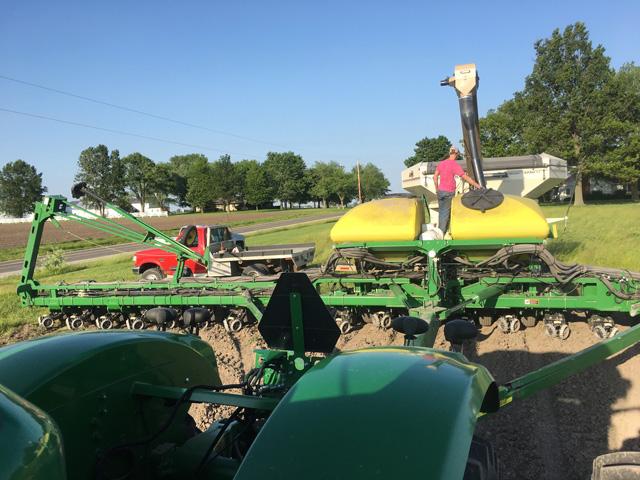Best Blog of the Week
Production Blog: Tips to Get Seed in Planting Condition
Athletes stretch before a game. You warm a tractor up before hitting full throttle. Even the barbecue grill gets brought to temp before slapping on a burger. But are you properly conditioning corn and soybean seed prior to planting?
Farmers spend a lot of time and money making sure they have the latest equipment to precisely place seed, but those measures don't guarantee the seed flows correctly through the planter. Dana Harder, field agronomist with Burrus Seed, recommends bringing seed up to ambient temperatures before planting to avoid a gummed-up mess.
"A lot of seed is stored in the shed on cold concrete floors. Preconditioning seed by letting it equilibrate to the approximate temperature in the field is a good practice to help with flowability," Harder told DTN.
Harder said research has shown the probability for condensation increases when ambient temperatures are more than 20 degrees warmer than seed temperature. As the spring season progresses toward summer, temperatures and humidity swings tend to increase the potential for condensation on seed pulled directly out of storage, he noted.
The container the seed is stored in also makes a difference in how fast it acclimates. Bags contain less seed and therefore are likely to warm up faster, he noted. "A poly bag isn't going to be as much of a barrier to getting temperature equalized as a pro box," Harder said.
"We like to see seed given a day or two to acclimate to field conditions," Harder said. "It's always important to check to see if there is dampness or stickiness as the planter is filled. Seed lubricants can sometimes help ease these issues, especially if you don't have time to precondition seed."
IT'S A STICKY ISSUE
Seed treatments applied to help protect from all sorts of early-season threats are hygroscopic or "water-loving."
P[L1] D[0x0] M[300x250] OOP[F] ADUNIT[] T[]
"Water is a carrier in the application process," Harder said. "But this also means treated seed can readily absorb moisture under humid environments. It also means the surface area of treated seed is larger, which allows for greater absorption of moisture."
The type of planter can also be a factor. Bulk-fill and vacuum-style planters move and concentrate airflow, Harder noted. This concentrated air is often warmer than ambient air temperatures because of the heat generated by fans used to move seed.
"This results in a more humid environment inside the planter and can increase seed stickiness. Seed can readily generate static electricity by rubbing against the plastic parts within the planter unit and result in seed hang up," Harder added.
GO WITH THE FLOW
Seed lubricants come in several forms but check the planter manual before choosing one. Manufacturer recommendations do vary.
Here's how Harder classifies the options.
Graphite -- serves as a lubricant to decrease mechanical wear and acts as an electrical conductor to ground static electricity in the planter. Using too much can decrease singulation and dirty up planter sensors and cause them to read inaccurately.
Talc -- can act as a drying agent by filling the hygroscopic pores in the treated seed and preventing moisture from being absorbed. It also acts as an electrical insulator to prevent transfer of static electricity. Excessive talc can result in off-target dust of seed-applied insecticides.
Fluency agents -- act as a lubricant to decrease wear in mechanical parts and serve as an electrical insulator. They can reduce seed treatment dust off and are less messy than graphite, but they can also be waxy. Too much can make the planter meter sticky or gummy, particularly in humid planting conditions, and result in seeding skips.
MIX WELL
Thoroughly mix in any seed lubricant. "Research has shown partially mixed lubricant only improved seed flow by 12%, compared to not using any lubricant at all. However, if a seed lubricant is thoroughly mixed, seed flowability improved 156% compared to using no lubricant," Harder said.
"But by far, the big mistake farmers make is using too much lubricant. They can be helpful in some cases, but this is also a situation where too much of a good thing can be too much."
What if you have a planting delay and need to pull the seed back into a protected environment? "Begin the precondition process when planting becomes suitable again," Harder says. "It's important to be pragmatic on this process. It can be as simple as opening the shed doors in advance so that temperature and humidity acclimate."
Find the complete blog from Dana Harder, Burrus Seed field agronomist, here: https://burrusseed.com/…
Want to check how well your planter performed? Try flagging corn emergence. Read how to do it here: https://www.dtnpf.com/…
Pamela Smith can be reached at pamela.smith@dtn.com
Follow her on social platform X @PamSmithDTN
(c) Copyright 2024 DTN, LLC. All rights reserved.




